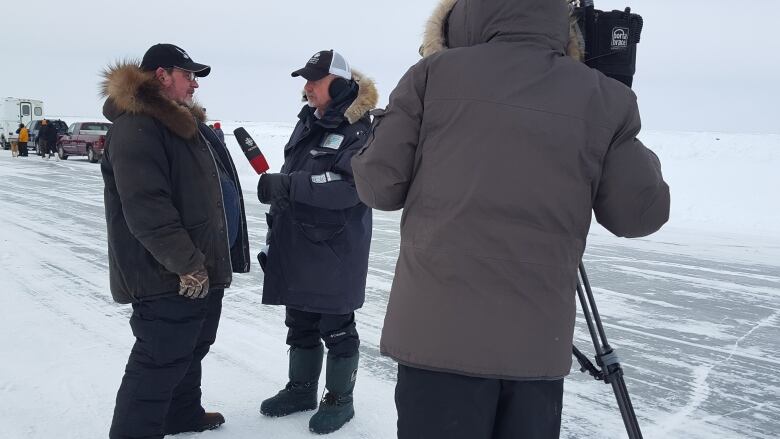Watch Inuvik's majestic reindeer herd make its annual ice road crossing
Every year, Lloyd Binder's reindeer cross the ice road on their way to summer pasture

CBC's Northbeat went to Inuvik this week, in part to watch 3,000 reindeer make their annual ice road crossing, and to hear from long-time reindeer herder and owner, Lloyd Binder, about the family business.
Stay tuned to hear from chief herder Lawrence Amos and his 11-year-old grandson.

- RELATED | 'I'm gonna miss the reindeer': Inuvik's chief reindeer herder hangs up his lasso
- RELATED |Otto Binder, legendary reindeer herder and RCMP special constable, dies at 93
The following is a full transcript of Northbeat hostRandy Henderson'sinterview with Binder.
This is an annual migration... for those of us who are new to this, where are the reindeer coming from, and where are they going?
We're moving the reindeer from the winter grazing area... to the summer area on Richards Island. The herd will be here from now until we collect them again in mid-November and bring them southeast, to just north of Inuvik.
What perils do they face along the way?
Relatively few because we're with them all the time. The only real risk is a mad driver zooming through here!
At other times of the year, would predation be a problem?
Wolves are the problem, in the winter. However, grizzlies are coming out soon and there are several that den on the island. They will take some animals too. But we live with that there's always a certain amount of loss. One year was particularly odd the ravens killed a couple of dozen fawns. It was strange... but they are raptors after all.
What is the reindeer market like right now?
It's good and growing. We are close to killing our safe, sustainable yield. So our plan is to grow the herd to about 6,000and double our meat output.
How many do you have now?
We have about 3,000. After fawning we should have about 5,000... and fawning starts any day now.
And who buys your reindeer meat, primarily?
Mostly in the N.W.T. and most in the Inuvialuit region. As well, through the Inuvialuit Regional Corporation, we do a meat program with them... so they feed the Inuvialuit communities of Sachs Harbour, Ulukhaktok, Tuktoyaktok, Inuvik, Aklavik.
Fifteen years ago you were able to purchase the herd. I understand it was a dream come true for your family, especially your father, Otto Binder. Can you talk about that?
My father saw the reindeer come through when he was a young boy at Shingle Point, so he was intrigued. And so when there was a job, he took it. And eventually married the chief herder's daughter... my mother... and acquired a herd of his own. But his range was not suited for year-round grazing. So he turned his herd back to the government and became a game warden, an RCMP officer, ship's captain, bush economist... and when the opportunity came to once again acquire the herd, he said let's do it.
So what does the future look like, for you and the herd?
It's looking promising... a growing demand for meat and meat products. The herd's survival rate is good. The opportunity for growth is here. We can reduce loss and increase herd numbers... there's no reason to have a large herd unless you need a large herd... and so we're going that way.
All the best going forward.
Thank you.
With files from Joslyn Oosenbrug












_(720p).jpg)


 OFFICIAL HD MUSIC VIDEO.jpg)
.jpg)



























































































